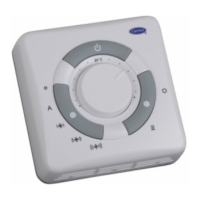PG80VTLA: Installation, Start-up, Operating and Service and Maintenance Instructions
Manufacturer reserves the right to change, at any time, specifications and designs without notice and without obligations.
28
Air for combustion must not be contaminated by halogen compounds
which include chlorides, fluorides, bromides, and iodides. These
compounds are found in many common home products such as
detergent, paint, glue, aerosol spray, bleach, cleaning solvent, salt, and
air freshener, and can cause corrosion of furnaces and vents. Avoid using
such products in the combustion-air supply. Furnace use during
construction of the building could cause the furnace to be exposed to
halogen compounds, causing premature failure of the furnace or venting
system due to corrosion.
Vent dampers on any appliance connected to the common vent can cause
condensation and corrosion in the venting system. Do not use vent
dampers on appliances common vented with this furnace.
Additional Venting Requirements
A 4-in. (102 mm) round vent elbow is supplied with the furnace. A 5-in.
(127 mm) or 6- in. (152 mm) vent connector may be required for some
model furnaces. A field-supplied 4-in. (102 mm) to 5-in. (127 mm) or
4-in. (102 mm) to 6-in. (152 mm) sheet metal increaser fitting is required
when 5-in. (127 mm) or 6-in. (152 mm) vent connector is used. See
Fig. 38 - Fig. 50 for Venting Orientation of approved vent
configurations.
NOTE: Vent connector length for connector sizing starts at furnace vent
elbow. The 4-in. (102 mm) vent elbow is shipped for upflow
configuration and may be rotated for other positions. Remove the three
screws that secure vent elbow to furnace, rotate furnace vent elbow to
position desired, reinstall screws. The factory-supplied vent elbow does
NOT count as part of the number of vent connector elbows.
The vent connector can exit the furnace through one of five locations on
the casing.
1. Attach the single wall vent connector to the furnace vent elbow, and
fasten the vent connector to the vent elbow with at least two
field-supplied, corrosion-resistant, sheet metal screws located 180_
apart.
NOTE: An accessory flue extension is available to extend from the
furnace elbow to outside the furnace casing. See Product Data Sheet for
accessory listing. If flue extension is used, fasten the flue extension to
the vent elbow with at least two field-supplied, corrosion-resistant, sheet
metal screws located 180_ apart. Fasten the vent connector to the flue
extension with at least two field-supplied, corrosion resistant sheet metal
screws located 180_ apart.
2. Vent the furnace with the appropriate connector. (See Fig. 38 -
Fig. 50).
3. Determine the correct location of the knockout to be removed.
4. Use a hammer and screwdriver to strike a sharp blow between the
tie points and work the slug back and forth until the slug breaks
free.
An accessory Vent Guard Kit is REQUIRED for downflow applications
for use where the vent exits through the lower portion of the furnace
casing. Refer to the Vent Guard Kit Instructions for complete details.
See Product Data Sheet for accessory listing.
The horizontal portion of the venting system shall slope upwards not less
than 1/4-in. per linear ft. (21 mm/m) from the furnace to the vent and
shall be rigidly supported every 5 ft. (1.5 M) or less with metal hangers
or straps to ensure there is no movement after installation.
Sidewall Venting
This furnace is not approved for direct sidewall horizontal venting.
Per section 12.4.3 of the NFPA 54/ANSI Z223.1, any listed mechanical
venter may be used, when approved by the authority having jurisdiction.
Select the listed mechanical venter to match the Btuh input of the
furnace being vented. Follow all manufacturer’s installation
requirements for venting and termination included with the listed
mechanical venter.
Caution!! For the following applications, use the minimum vertical heights as specified below.
For all other applications, follow exclusively the National Fuel Gas Code.
NOTE: All vent configurations must also meet National Fuel Gas Code venting requirements NFGC.
CAUTION
!
BURN HAZARD
Failure to follow this caution may result in personal injury.
Hot vent pipe is within reach of small children when installed in
downflow position.
See the following instruction.
CAUTION
!
CUT HAZARD
Failure to follow this caution may result in personal injury.
Sheet metal parts may have sharp edges or burrs. Use care and wear
appropriate protective clothing, safety glasses and gloves when
handling parts, and servicing furnaces.
FURNACE
ORIENTATION
VENT ORIENTATION
FURNACE INPUT
(BTUH/HR)
MIN. VENT
DIAMETER
IN. (mm)
*
*. 4-in. (102 mm) inside casing or vent guard
MIN. VERTICAL VENT
HEIGHT
FT. (M)
†
†. Including 4 in. (102 mm) vent section(s)
Downflow
Vent elbow up then left
Fig.41
110,000 5 (127) 10 (3.0)
Downflow
Vent elbow left, then up
Fig. 44
110,000
132,000
5 (127) 12 (3.6)
Downflow
Vent elbow up, then right
Fig. 45
110,000 5 (127) 10 (3.0)
Horizontal Left
Vent elbow right, then up
Fig. 46
132,000 5 (127) 7 (2.1)
Horizontal Left
Vent Elbow up
Fig. 47
132,000 5 (127) 7 (2.1)

